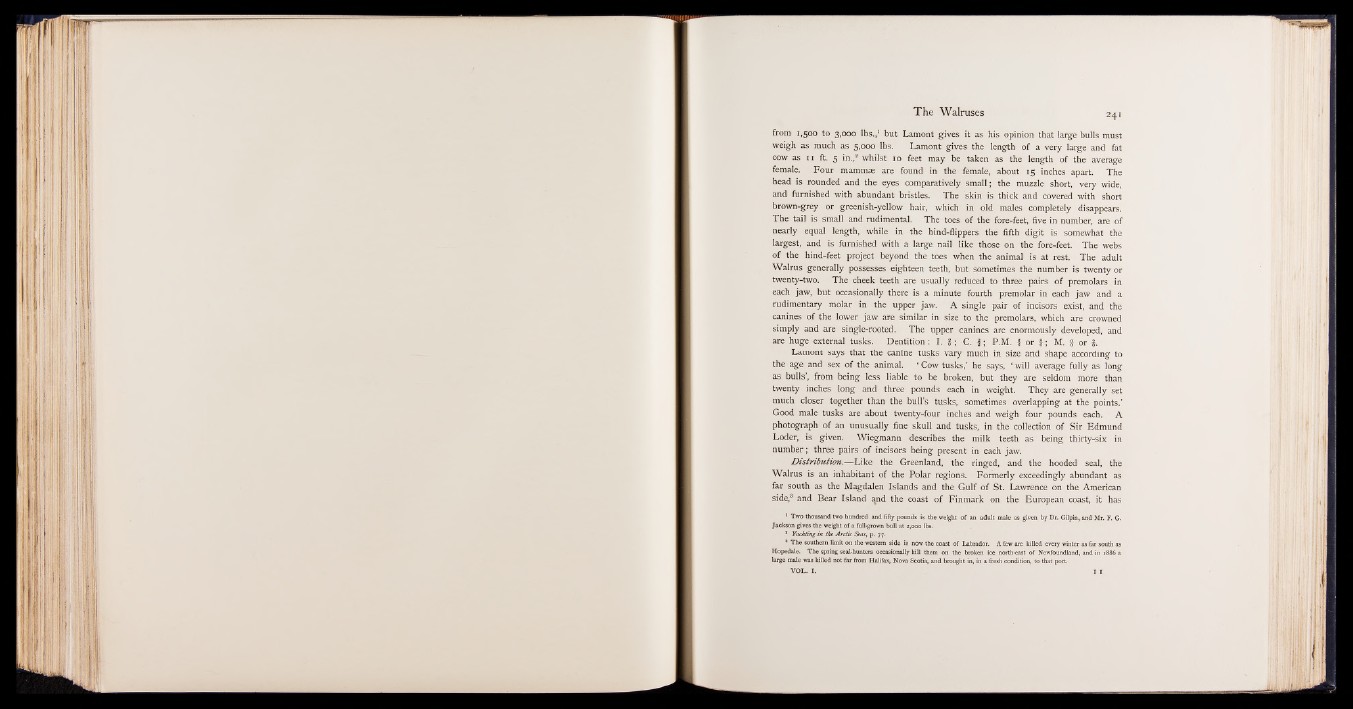
from 1,500 to 3,000 lbs.,1 but Lamont gives it as his opinion that large bulls must
weigh as much as 5,000 lbs. Lamont gives the length of a very large and fat
cow as 11 ft. 5 in.,2 whilst 10 feet may be taken as the length of the average
female. Four mammas are found in the female, about 15 inches apart. The
head is rounded and the eyes comparatively small; the muzzle short, very wide,
and furnished with abundant bristles. The skin is thick and covered with short
brown-grey or greenish-yellow hair, which in old males completely disappears.
The tail is small and rudimental. The toes of the fore-feet, five in number, are of
nearly equal length, while in the hind-flippers the fifth digit is somewhat the
largest, and is furnished with a large nail like those on the fore-feet. The webs
of the hind-feet project beyond the toes when the animal is at rest. The adult
Walrus generally possesses eighteen teeth, but sometimes the number is twenty or
twenty-two. The cheek teeth are usually reduced to three pairs of premolars in
each jaw, but occasionally there is a minute fourth premolar in each jaw and a
rudimentary molar in the upper jaw. A single pair of incisors exist, and the
canines of the lower jaw are similar in size to the premolars, which are crowned
simply and are single-rooted. The upper canines are enormously developed, and
are huge external tusks. Dentition: I. #; C. P.M. f or f ; M. # or #.
Lamont says that the canine tusks vary much in size and shape according to
the age and sex of the animal. ‘ Cow tusks,’ he says, ‘ will average fully as long
as bulls’, from being less liable to be broken, but they are seldom more than
twenty inches long and three pounds each in weight. They are generally set
much closer together than the bull’s tusks, sometimes overlapping at the points.’
Good male tusks are about twenty-four inches and weigh four pounds each. A
photograph of an unusually fine skull and tusks, in the collection of Sir Edmund
Loder, is given. Wiegmann describes the milk teeth as being thirty-six in
number; three pairs of incisors being present in each jaw.
Distribution.— Like the Greenland, the ringed, and the hooded seal, the
Walrus is an inhabitant of the Polar regions. Formerly exceedingly abundant as
far south as the Magdalen Islands and the Gulf of St. Lawrence on the American
side,8 and Bear Island and the coast of Finmark on the European coast, it has
1 Two thousand two hundred and fifty pounds is the weight of an adult male as given by Dr. Gilpin, and Mr. F. G.
Jackson gives the weight o f a full-grown bull at 2,000 lbs.
* Yachting in the Arctic Seas, p. 77.
* The southern limit on the western side is now the coast of Labrador. A few are killed every winter as far south as
Hopedale. The spring seal-hunters occasionally kill them on the broken ice north-east of Newfoundland, and in r886 a
large male was killed not far from Halifax, Nova Scotia, and brought in, in a fresh condition, to that port